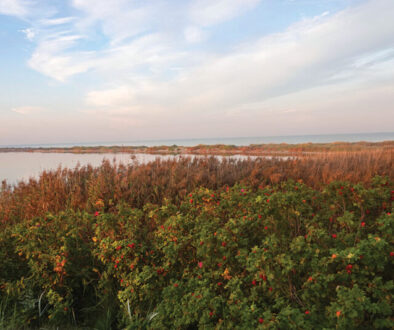From the Ground Up: The Journey to Cape May’s New Firehouse
How a community initiative came to life, start to finish.

Whether you’re new to Cape May or have lived there for decades, the unveiling of the new—and $5.2 million—firehouse was a moment of celebration that resonated throughout the city during its ribbon cutting on Wednesday, November 29, 2023. It was both a moment of gratification for the people of Cape May, as well as the firefighters, politicians, and task force who worked on the project, and the culmination of almost a decade of planning, designing, and construction.
Cape May Magazine spoke with some of the key players involved with the endeavor, including [now former] City Manager Mike Voll, Cape May Fire Chief Alex Coulter, Former Cape May Fire Chief Barney Dougherty, project architect Rob Conley of Robbie Conley Architect, and Cape May Mayor Zack Mullock about the goals, the process, and the outstanding results of Cape May’s brand-new firehouse.
Setting the Scene
Until recently, the Cape May Fire Department, which formed in the late 1800s, was housed in a 1970s-fire station that was in a serious state of disrepair. According to Cape May Fire Chief Alex Coulter, the previous firehouse wasn’t just outdated; it was also downright dangerous.
“Aside from the problems we had with the building with the leaky roof, mold, rodents, insects, and stuff falling down, we weren’t compliant with the NFPA (National Fire Protection Association),” says Chief Coulter. “There were all kinds of issues we were constantly trying to take care of for the health and safety of the personnel that work here, from a lack of decontamination areas that were able to be used, to not being able to fit our apparatus in the building. The deputy chief and I would have to leave our vehicles running during inclement weather because we couldn’t bring them inside—there just wasn’t any room.”
Add to that an increase in call volume—between fire and EMS (emergency medical services), they run 2600 calls per year—that puts a continuous strain on facilities. The condition of the former firehouse was hazardous enough for Coulter to begin his search for solutions almost 10 years ago.
“When I started this process back in 2014, I did it without the city really knowing I was embarking on this adventure,” says Coulter. “We outgrew the old building because the crew department is constantly expanding due to our call volume increasing and our demands going up.”
Coulter met with architect Rob Conley, and the two of them conducted needs assessments on the building—which were costly and lengthy—then put together a proposal, and pitched it to the city. At that time, it went nowhere.
Challenges and Roadblocks
A few years after that initial pitch, Coulter tried another approach. “I chatted with the police administration at the time, and we tried to embark on a joint venture,” he says.
That joint venture would be an enormous public safety building that would house both a firehouse and a police station. The plan was up to 37,000 square feet in size with a 2019 estimate that came to a whopping $24 million. It also came with plenty of contention.
“After 22 months, I had to resign from that committee, and I’ve never resigned from any committee in my life,” says Dougherty, of his time on the public safety building committee. “But it got to the point where it was on the verge of being ridiculous.”
“It was a huge expense. A huge building. And it didn’t have parking,” says Cape May Mayor Zack Mullock, about the proposed public safety building. “Ultimately, we put it on a ballot for a vote and on that vote, the question was ‘Are you for a public safety building, a firehouse, or nothing?’ The firehouse won. As soon as we got into office, we hired an architect, formed a task force, and got to work pretty quickly—especially considering that was what the citizens wanted.”
“It had become a bit of a political football, unfortunately,” says Coulter. “Luckily for us, we’re working with the administration now that was very proactive on getting this going and has been a great help along the way—because I’ve essentially become the project manager on the site for the last couple of years. And it’s quite a project.”
Community Involvement
An undertaking like a city firehouse doesn’t happen overnight, or in a vacuum. Especially not in Cape May, where the community is tight knit, and the historic nature of the town requires that new buildings meet preservation specifications. Instead, it takes a village—or at the very least, a task force.
“The community of Cape May voted for this, and they paid for it through their tax dollars. So of course, we had professionals on the task force, but we included the community as well,” says Mullock.



The task force, which included members such as former Cape May Fire Chief Barney Dougherty, former Cape May Mayor Bob Elwell, and Warren Coupland, head of the Historic Preservation Commission, was instrumental in propelling the project, offering insights, opinions, and their professional experience in order to create a firehouse that would satisfy all the stakeholders.
For architect Rob Conley, an emergency service buildings specialist who has designed fire, ambulance, and police stations throughout the state of New Jersey, the primary difference between the Cape May firehouse and the dozens of others he’s designed was creating a structure that would manage to fit the fabric and the look of the city, while still being a state-of-the-art facility.
“The biggest thing is that buildings that were built in the 1890s were not built to withstand the storms and everything else we design firehouses to withstand,” says Conley. “So, we had to design a building that would withstand the requirements of today—code-wise and in terms of strength of storms—but look similar to a building that would have been built in the 1890s. We worked with the city and Warren and a couple other people from the Historic Preservation Commission, and I think we came up with a very successful design that looks the part and will be able to last 50 to 100 years for the city.”
Project Construction
Construction on the new firehouse finally got underway in 2020, with expectations that the project would be completed in March 2023. By early December 2023, at the time of this writing, though the ribbon had been cut on the firehouse, the firefighters hadn’t yet moved in.
“It took us longer to get things done than it should have,” says Voll. “But there were supply issues during the way that held things up with subcontractors.”
Though the project took a few months longer than initially anticipated, it stayed remarkably close to its $5 million budget. Conley, a firefighter himself, credits the simplicity of design.
“We do a lot of these buildings throughout the state and have developed an economical way to have the builders do it,” says Conley. “We keep the design of the building simple, and we bring more in under budget than not, keeping the change orders below 5% normally. We keep the building simple, and we do a very tight drawing and set of specs.”

Though the Cape May firehouse did run slightly over budget due to some change orders, it was exceptionally close, especially considering the experiences of other towns. According to Mullock, another firehouse being built in South Jersey has already had $5 million in change orders alone—that’s on top of the allocated budget.
“We had a budget of $5 million and came in with a total of $5.3 million with a larger building,” says Mullock. “We took a vote on it as a task force. We didn’t want to create a building that was undersized that would need to be changed, just to make the budget. But we did it for under 3% in change orders, which was really hard, especially during labor and material shortages.”
Features of the New Firehouse
For the last 18 months, Cape May firefighters have been accommodated by the West Cape May Volunteer Fire Department. And though there is mutual respect and camaraderie between the units, the Cape May firefighters are likely to be thrilled with their new facility.
“It’s going to be like they’re going from an old Chevette to a brand-new Mercedes,” says Voll.
“It’s a good building,” says Dougherty. “Nothing is perfect in this world, and there are a few little things there that I wish we could have done a little bit better. But overall, it’s a fine building, and it will give them some good, comfortable facilities to live in, which was lacking for many years.”



“Just being a newer building that’s designed for today’s fire service makes the life of the firefighter so much easier and better,” says Conley. “When the previous firehouse was built, it was mostly for a volunteer department. Now you have career firefighters that are living there day in and day out.”
The new building is designed with both volunteer and career firefighters in mind, improving things like morale but also contributing hugely to safety measures, things as simple as turnout gear storage.
“When firemen go to fires, you don’t think of the hazardous chemicals of the smoke that gets in their turnout gear,” says Conley. “In the other building, their fire gear was out in the engine bays, as was the storage, so the firefighters had to walk through smelling the gear. This building has a special room with gear washers, and a space for drying their gear. Something as simple as that is a major thing for the health and safety of the firefighters.”



And of course, there’s plenty of room. “We don’t have to worry about overcrowding, which was an issue in the old firehouse,” says Coulter. “We work 24 hours on and 48 hours off, so the guys have to sleep here as long as they’re not up and running calls. Just the ability to have their own space, when they have reports to do, training and schooling to keep up on, is a big boost for morale. And now we have seven bunk rooms with 18 beds, and the deputy and I have the ability to set up in our offices, which is nice because we are looking to expand. We don’t currently have enough people to keep operating with the call volume increasing as much as it has.”
In addition to space and the new bunk rooms, there’s a state-of-the-art decontamination area, a new kitchen, a dedicated weight room (the previous firehouse had weight equipment placed in the bay between fire trucks), and a lounge. And the firefighters? According to Coulter, they’re ecstatic.
Community Impact
Keeping our firefighters safe, happy, and healthy is imperative, but the firehouse is important for the entire community, not just those living and working out of it.
“Our paid fire department responds quickly. If there’s a little fire, it’s put out quickly, and we’ve been really fortunate not to have things expand to a major fire,” says Voll. “Because once it starts with all those crispy old homes, it’s going to keep going.”
The Cape May firefighters are good at their jobs, and those jobs require continuous training and learning opportunities. The new firehouse has the space for them to learn what they need to continue protecting the community of Cape May.
“We are a very fast and efficient department,” says Coulter. “By the time a call gets in, we’re two minutes or less to pretty much anywhere in town. Our track record is very good, and the citizens of Cape May are very supportive of us because of that.”
It’s more than putting out fires, though. The new Cape May firehouse will also act as an emergency shelter in the event of a major storm, with 50 cots on the premises.
“It was super important to make this a place you want to go in a time of need,” says Mullock. “The city can host trainings and that kind of stuff there as well. We couldn’t fit people in the previous version. This is a beautiful victory for the whole town working together. The building will serve the community, as is, for decades to come and still have some space to grow.”
Looking Ahead
With a brand-new fire station, Cape May firefighters are poised to grow and continue to develop. And the city can rely on their superb response rate, as well as their well-being.
“We’re currently in the process of ordering our new engine,” says Coulter. “And that’s going to allow us to take our 1995 engine, which we’re still using, and put that in the reserve capacity.”
However, the police department, which would have been part of the formerly proposed joint public safety building, has been patiently waiting for their turn.
“The police department has been so patient and professional throughout the whole process,” says Mullock. “But we have already bonded $5 million for a new police station without a tax increase. It was planned in a very responsible way, and we’re just waiting on DEP approval for a land diversion of Lafayette Street Park on the corner, which is a great location for response time.”
According to Mullock, it looks like the DEP is moving towards approving that land transaction, and if it’s approved, the plan is to move ahead—quickly—on a new police station.
“The project is an 18-month-project,” says Mullock. “So, we are really hoping by January 1st we will have an answer. If we do, we have to wait for the legislature to approve. Say we have full approval by June 1, we would look to put the shovel in the ground the next day. So, 18 months from there we’d have a new police station. Then we would have two standalone, beautiful buildings for our firefighters and our police department.”
“I’m really excited.” Along with the rest of Cape May.
The Cape May Fireman’s Museum
Text and photos by Kate Chadwick
There is a tiny building next to the big new firehouse, neatly (and adorably) situated on the corner of Washington and Franklin. This petite structure packs a big historical punch, an immersion into the past. It is the Cape May Fireman’s Museum, built by volunteer and career firemen in 1984. Lieutenant Jeff Laag of the Cape May Fire Department is its caretaker.
Originally designed and constructed to house the CMFD’s 1928 American LaFrance fire truck, Jeff has built it into a true museum during his 20-year career. Although the truck is undoubtedly the star of the show, its supporting cast includes a Victorian fire escape and vintage photos and articles about Cape May firefighters of days gone by. But first things first.
Festooned with laminated—and, according to Jeff, largely unheeded—signs warning “Please do not touch,” the truck is dazzling, whether you’re an automotive fan or not.



The truck hits the road for “parades, car shows, the firemen’s convention, things like that,” Jeff said. “It underwent a restoration starting about seven years ago, first the mechanical features, then the engine, electrical systems, and gold plating.” Completed two years ago, about $75-80,000 was spent restoring it. “But it’s irreplaceable.”
Fully functional, the truck has a top speed of about 50 miles per hour. “But it only has rear brakes, so it’s a handful,” Jeff said. The wheel spokes are wooden. “The rim is metal, but if you hit a curb and break one of these spokes, you’re going to a carriage maker to have a new one made.” The striping and lettering are hand-applied gold leaf, its varying shades representing different karats.
The rest of the room features memorabilia displays Jeff has assembled over time. “Some people donate, some people leave them to us. We try to give general knowledge through them of how things have progressed,” Jeff said. “A lot of these photos and renderings are courtesy of Ben Miller, who donated them after an exhibit at the Physick Estate. It’s great to have this history and information for people to see how far things have come—like this old photo of our fire department with its horse-drawn contingent.”
The horses were apparently trained so well that when a call came and the bell went off, they’d automatically go to their harnesses and walk right into them. Jeff points to another old photo of the CMFD lined up in front of their station, a pile of horse manure in frame in the left foreground. “If you think about it, a pile of horse manure to them is like an oil stain to us.”
Two mounted glass display cases are filled with patches, via a give-a-patch, get-a-patch program Jeff started. “I’ve got boxes of more that I’ve run out of room to display!” Mounted underneath one is an old ladder. “They called it a banger ladder. It’s 55 feet, which is gigantic to put up by hand. We don’t use them anymore, but love being able to show people a hand-thrown ladder of that size.”
A narrow spiral staircase towards the back of the space is roped off; next to it is a fireman’s pole from the original Cape May Firehouse. Upstairs is for storage, Jeff says. “Because of the staircase and the pole, we don’t really want people up there.”
Jeff was interrupted by a call from a property owner, and patiently explained the procedure for the reset of an alarm system. And just like that, we were back in the present day.
The CMPD Fireman’s Museum is open from 9am-8pm from April through December. It is self-guided and free, but there is a donation box. And please, don’t touch the truck.



